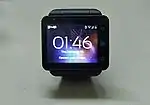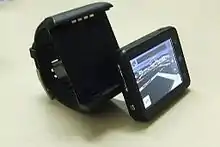Neptune Pine
The Neptune Pine is an unlocked GSM standalone,[1][2] full-featured smartwatch developed by Canadian consumer electronics and wearable technology company Neptune.[3] It was announced in January 2013 by Simon Tian and launched in November 2013 on Kickstarter. Within 27 hours, the campaign reached its funding goal of $100,000, and ultimately went on to raise more than $800,000 in 30 days, becoming the highest funded Canadian Kickstarter campaign at the time.
 | |
| Compatible networks | GSM/GPRS/EDGE 850, 900, 1800, 1900, UMTS/HSPA+/WCDMA 850, 1700, 1900, 2100 |
|---|---|
| Availability by region | January, 2014 |
| Type | Standalone smartwatch |
| Dimensions | 66.0 x 53.5 x 14.2 mm |
| Mass | 60.8 grams / 2.14 ounces |
| Operating system | Android 4.1 Jelly Bean |
| CPU | Qualcomm Snapdragon S4 Play MSM8225 (1.2GHz Dual- Core ARM Cortex-A5) |
| Memory | 512MB RAM |
| Removable storage | internal, non removable 16 or 32GB mass storage |
| Battery | 810 mAh lithium-ion battery Charging via USB to computer system or power adapter |
| Data inputs | Capacitive Touchscreen |
| Display | 2.4" inch, TFT |
| Rear camera | 5.0 MP rear-facing camera, VGA front-facing camera, LED flash (Front & Rear) |
| Connectivity | Wi-Fi 802.11 b/g/n, Bluetooth 4.0 (voice, stereo), USB 2.0, Micro-SIM |
The device started shipping by August 2014, and eventually became widely available through Best Buy and Amazon, generating around $5 million in total retail sales. It was prominently featured in the 2017 film The Fate of the Furious, the CBS TV series Extant starring Halle Berry and the music video for Smartphones by Trey Songz. The Pine has gotten mixed reviews from the press, generally praising its extensive set of features, while criticizing its large size.
Funding
After a successful campaign on Kickstarter Neptune managed to raise over $800,000 out of a goal of $100,000.[4]
Features
It uses Google Android version 4.1, but is not a Google-licensed device and therefore does not include Google apps or the Google Play store. These apps can be manually added by the user.
The Pine has a Snapdragon S4 system on a chip (SoC) by Qualcomm that has a Cortex-A5 Dual- Core ARM processor running at 1.2 GHz.
The smartwatch has a Capacitive Touch screen, a Wi-Fi web browser, a 5.0 MP rear-facing camera and a VGA front-facing camera, both of them with LED flash, a multimedia player and recorder for music (mp3) and video (mp4), a 3.5mm headphone jack and an internal GPS antenna that supports satellite navigation. Other data inputs are: an accelerometer a gyroscope a pedometer and a digital compass.
The Pine smartwatch can be released from the wrist strap by pressing a button on the strap for a better audio signal during a phone call or to take photos with the 5MP rear-facing camera which it's otherwise blocked by the strap.

A Micro B USB to USB cable is required to charge the smartwatch and it can also be used to connect to a computer so that the internal SD card can be recognized as a mass storage device for file management.
As a phone, it can be used in conjunction with a Bluetooth headset and can operate in a hands free manner with its built in microphone and speakers, also it's Bluetooth functionality supports Stereo Bluetooth for wireless music playback and making calls. It offers a talk time of up to 8 hours on 2G and 6 hours on 3G. Also the Internet use is up to 7 hours and music playback is up to 10 hours.[5]
The watch was originally intended to be waterproofed, but it was discovered that the treatment they wanted to use could not be applied by their manufacturer. Kickstarter backers who wanted waterproofing could have their devices shipped to a thirdparty, opened, and treated with the aftermarket HzO spray before delivery, however this option is not available at retail.
References
- http://www.citeworld.com/article/2113510/mobile-byod/12-pros-and-cons-cellular-smartwatch.html The pros and cons of a cellular smartwatch
- https://venturebeat.com/2014/03/06/4-kickstarter-projects-taking-on-tech-giants-in-the-wearables-industry/ 4 Kickstarter projects take on tech giants in the wearables industry
- "Neptune Computer Inc. - Techvibes.com". Techvibes.com. 2014-12-27.
- https://www.kickstarter.com/projects/neptune/neptune-pine-smartwatch-reinvented Neptune Pine: Smartwatch. Reinvented.
- http://www.getneptune.com/data-sheet Neptune Pine official tech specs
External links
- Official website of the Neptune Pine
- Engadget.com - Here's what it's like to use a watch as a phone
- XDA-developers.com – Forum: Neptune Pine (stand alone, android, smart watch/phone)
- Neptune Pine chatting community
- Official Neptune Pine videos
- Neptuneninja.com – Resources, apps and hardware guides for the Neptune Pine